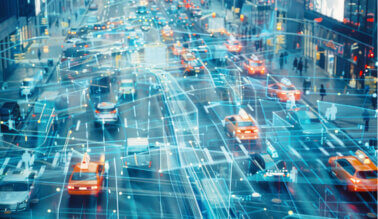How cellular connectivity helped broadcast the Olympics to the biggest
audience ever
by Amit Shvartzberg
The 2024 Paris Olympics were record-breaking not only in sports. These Olympic Games saw the biggest broadcasting audiences ever, and a record output across both TV and digital platforms.
In our previous post on connectivity at the Olympics, we mentioned some estimates and trends regarding the increasing size of the audience and the number of broadcast hours. It proved to be relevant to the Paris Olympics too. During a press briefing halfway through the Games, IOC President Thomas Bach said that more than half of the world’s population would have watched the Paris 2024 Olympics by its conclusion on August 11. As for the number of broadcast hours, for the 2024 Games, OBS, the host broadcaster for the Olympics, used over 1000 cameras to produce over 11,000 hours of content. The output across both TV and digital platforms is a 15.8% increase in the amount of content produced for the Tokyo 2020 Olympics and more than any previous Olympic Games.
Audience Records
With final figures yet to be published, many broadcasters reported a huge increase in their audiences from the very first days of the Games.
For example, American media giant NBCUniversal informed that its broadcast from Paris drew a combined average of 30.6 million viewers across NBCU’s constellation of platforms, marking an 82% jump in viewership compared to the Tokyo Games. Its coverage was impressive, too: 23.5 billion minutes of stream time, a 40% increase over the total streaming time of all previous summer and winter Games combined, while its total audience included 4.1 million daily viewers.
Warner Bros. Discovery, which was broadcasting the Games in Europe and on its streaming platforms Max and Discovery+, announced that their cumulative reach was over 215 million – 23% more than Olympic Games Tokyo 2020. Moreover, after just two days of coverage their total unique streaming viewers for Paris 2024 had already exceeded those from the whole of Tokyo 2020. The number of streaming minutes – almost one billion – was more than seven times higher than at the same point of Tokyo 2020.

Broadcasting Records
The Paris Olympics were also a great achievement in terms of technical deployments. Starting prior to the Games, their official connectivity partner Orange worked hard on ensuring their network would be able to accommodate 15 million visitors watching and streaming competition on their mobile devices. The amount of data to handle was overwhelming: from 2 terabytes in one hour during the July 27 rugby final, to 100 terabytes during one of the finals of French superstar swimmer Leon Marchand. Moreover, the network had to support multiple broadcasting teams.
Broadcasters, in turn, built complex projects such as NBC’s transatlantic operations, with production teams at every site and venue in France and NBC’s broadcast operations center and other facilities in the US tied together by a supercharged web of connectivity. It included redundant 100-Gbps undersea fiber circuits and LiveU wireless backpacks to connect all kinds of cameras and even cellphones.
LiveU, one of the main providers of live video broadcasting solutions, has reported the most successful deployment in its history at the 2024 Summer Olympics in Paris. Over 1,000 LiveU portable units were used by broadcasters from 62 countries. The deployment was nearly a 40% increase compared to the previous Olympics in Tokyo and handled a massive 62TB of data transmission.
Webbing’s Contribution
Webbing’s eSIMs/SIMs were used to connect almost 1900 devices facilitated in broadcasting events and competitions at the Paris Olympics. From July 26th to August 11, Webbing’s core network transmitted about 30 terabytes of broadcasting data captured at the Olympic Games.
The dynamics of data usage show that while most broadcasting devices were used a few days prior to the opening and during the first week of the Games, the peak of data transfer is the 3rd of August, and during the closing ceremony the usage is significantly lower.


From July 26th to August 11, Webbing’s core network transmitted about 30 terabytes of
broadcasting data captured at the Olympic Games
This data is corroborated by other sources, such as NBC data, which claim that although the closing ceremony brought in 20.8 million viewers across all NBCU platforms and doubled that of the Tokyo Games, it was down 27.3% from the opening ceremony.
The Paris Olympics were not the first major sports event that Webbing solutions helped to broadcast. In 2022, at the FIFA World Cup in Qatar and the 2023 FIFA Women’s World Cup in Australia and New Zealand, Webbing eSIMs were used in mobile bonding devices that combine available cellular signals to provide better connection stability and more bandwidth, ensuring a smoother broadcast and seamless broadcasting operations across diverse locations and under dynamic conditions.
By providing independent access to multiple carrier networks, Webbing eSIMs help maintain connectivity in areas with restricted or unreliable mobile signals. Thanks to a distributed core network, they guarantee minimum latency, which is particularly crucial in the case of remote production that can add further latency when switching between multiple live feeds, mixing in commentator audio and video, or adding graphics.

Webbing’s Solution
Webbing offers a connectivity solution that ensures global access to reliable and high-quality internet, with low latency and the best of class coverage. It provides secure and continuous internet connection for devices on the move, wherever they need it.
As a global MVNO, Webbing’s network of 600+ mobile operators guarantee world-wide coverage. It allows to roam on several carriers’ network in every region, solving the problem of weak spots that any mobile network may have and ensuring full coverage and continuous connectivity for broadcasting production teams even at remote locations.
A distributed core network with local breakouts, multiple network solution, and data server redundancy helps Webbing provide stable connection, high data throughput and low latency to all roaming devices. It also ensures consistent bandwidth and a reliable connection for devices that use cellular bonding technology, allowing for flawless 5G 4K HEVC live streaming and remote production.
Our eSIM solution ensures failover connectivity with the capability of using multiple mobile carrier profiles, easily changing carriers at any time with zero integration, and an option to fall back from a failing profile to a different profile without any need to communicate with a remote server or deal with multiple SIM cards.
A flexible approach to data packages allows us to tailor our connectivity offering for every customer based on the type of connected devices and their data consumption needs as well as the locations where the devices are used, aiming at overall optimization of the total cost of operations for the client.
Our solutions help enterprises overcome their connectivity problems and optimize costs for global deployments, providing the benefits of roaming with multiple carrier options in every country, and seamless transition between carriers, while maintaining low rates and low latency on a global scale with a single SIM.
Reach out to learn more about our connectivity solutions.




